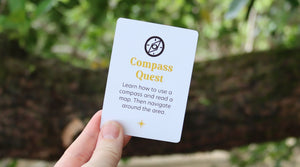Why Learn Animal Tracking?
Tracking animals is like solving a mystery. Every track tells a story about what creatures have passed by, what they were doing, and where they were going. By understanding tracks, you not only gain insight into the animal’s movements but also get to learn about their habitats and behaviour. It’s a great skill for kids, whether you're out bushwalking, camping, or simply exploring your backyard!How to Start Tracking
To begin, you’ll need to keep a keen eye on the ground. Soft dirt, mud, sand, and even grassy areas after rain are great places to spot animal tracks. Carry a notebook and pencil to draw the tracks you see and record your observations. If you have a camera, snapping a photo can help you compare your findings later.Remember to take your time. The more carefully you look, the more details you’ll notice!
Common Australian Animal Tracks
1. Kangaroo
- Track Shape: Kangaroo tracks are distinctive. You’ll often see the long, large footprints made by their powerful hind legs. The toes may spread out, and you might spot smaller handprints from their forelimbs as they balance.
- Habitat: Kangaroos are common across much of Australia. You can find them in open grasslands, forests, and bushlands. They tend to be more active at dawn and dusk, so these are the best times to find fresh tracks.
- Pro Tip: Look for long jumps between prints; this indicates a kangaroo was moving at speed!
2. Emu
- Track Shape: Emus leave large, three-toed tracks, and you can see the wide span between the toes. They walk in a straight line, so their tracks can appear evenly spaced along a clear path.
- Habitat: Emus are often found in open woodlands, grasslands, and even deserts. They roam freely across many parts of Australia and are usually seen in small groups.
- Pro Tip: Follow their tracks to watering holes or areas where they might have been searching for food.
3. Dingo
- Track Shape: Dingo tracks look like a domestic dog's but are narrower. They show four distinct toe prints with a large pad at the back. Unlike dogs, dingoes’ tracks typically don’t have claw marks because their claws are more retracted when walking.
- Habitat: Dingoes can be found in many environments, from deserts to coastal regions. They are especially common in the outback and along bushland fringes.
- Pro Tip: Dingo tracks often follow trails or roads, so look for them near well-worn paths.
4. Koala
- Track Shape: Koalas have unique tracks that show long claw marks from their front paws. The prints are small, and sometimes you might only see the scratches from their claws on trees rather than on the ground.
- Habitat: Koalas live in eucalyptus forests, especially in the eastern and southern parts of Australia. You’re more likely to find their tracks at the base of trees where they climb to feed.
- Pro Tip: Look up! If you spot tracks, a koala could be resting in the trees above you.
5. Wombat
- Track Shape: Wombat tracks are wide and round, with five toes and a distinctive claw mark. Their footprints are similar to a small bear's, and they leave deep, defined prints due to their weight.
- Habitat: Wombats live in burrows, often in hilly, forested regions. They prefer cooler areas, so you’ll find them in parts of Tasmania, Victoria, and southern New South Wales.
- Pro Tip: Wombats are nocturnal, so check for tracks early in the morning for the best chance of spotting fresh prints.
6. Goanna
- Track Shape: Goannas leave a distinct mark due to their claws and dragging tails. You’ll see small handprints with long claw marks, and a trail in the middle where their tail drags behind them.
- Habitat: These large lizards are found across most of Australia. They prefer warm environments, so you’ll often find them in dry forests, scrublands, and deserts.
- Pro Tip: Follow their tracks carefully to see if they lead to a burrow or tree, where they may have sought shelter or hunted for prey.
Animal Habitats and Their Importance
Understanding the habitat where you find tracks can give you clues about what animal left behind. Here’s a quick guide to the types of habitats you might explore in Australia:- Bushland: This is home to kangaroos, koalas, and wombats. Look for tracks around trees, trails, and water sources.
- Grasslands and Open Fields: Perfect for spotting emu and kangaroo tracks, as they roam freely in these areas.
- Deserts: The dry sand makes it easy to find dingo and goanna tracks. These animals are adapted to arid conditions, so their tracks often appear near oases or waterholes.
- Forests: Dense forests are home to wombats, koalas, and other creatures. The leaf litter may make it harder to spot tracks, but areas around watering holes or trails are good places to look.
Tips for Animal Tracking
- Be Patient: It might take time to spot animal tracks, especially in drier conditions.
- Track Size: Pay attention to the size of the prints. Larger tracks may indicate an adult animal, while smaller prints could mean a juvenile.
- Direction and Spacing: Note the direction the tracks are heading and how spaced out they are. Tracks that are close together suggest slow movement, while longer gaps between prints indicate running or hopping.
Bringing the Adventure to Life
Next time you’re out on an adventure, challenge yourself to identify as many animal tracks as possible. Grab your adventure cards, find a bushy area, and see how many different creatures you can track. It’s a great way to make your exploration more interactive and exciting.
Remember, animal tracking is all about observation and patience. Every footprint tells a story, and the more you practice, the better you’ll become at solving the mysteries of the wild!


